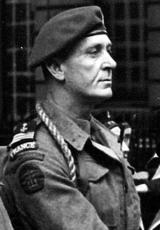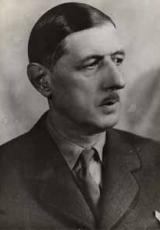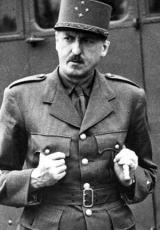The French on 6 June 1944
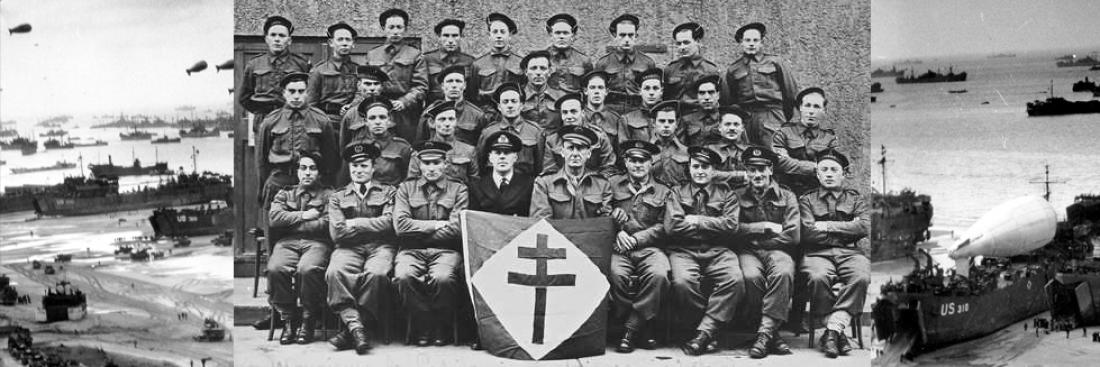
The French on 6 June 1944
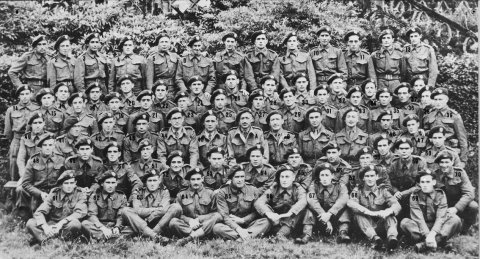
Commando Kieffer the day before the Normandy landing. Source: 4th Commando Museum
On 6 June 1944, Operation Overlord launched the first wave of Allied forces onto the Normandy coast to free Western Europe of the Nazi yoke. Only 209 Frenchmen took part as infantrymen - 177 commandos and 32 paratroopers - along with some one hundred fighter and bomber pilots and several hundred sailors from warships. Although they were not numerous compared with the flow of fighters who landed in France, these units were more than just bit players and their actions were testimony to their selflessness, their bravery and their patriotism under the Cross of Lorraine of the Free French and their leader, General de Gaulle.
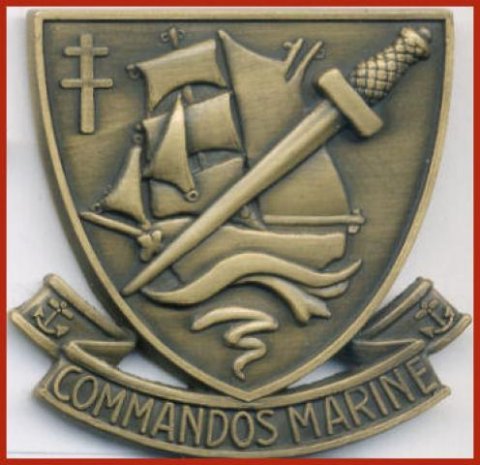
French navy commando beret insignia. Source: personal collection
Le commando Kieffer
This unit, the 1st battalion of fusiliers-marins commandos, was set up by Lieutenant Commander Philippe Kieffer. It was part of the Franco-British 4th Commando under Colonel Dawson and the 1st Special Service Brigade under General Lovat.
In Operation Overlord, the brigade was supposed to land first, preceding the British 3rd Infantry Division on the Sword Beach sector, with commando n° 4 attacking at Ouistreham. The 1st B.F.M. was given the difficult mission of capturing the large blockhouse built on the former Riva Bella Casino, surrounded by antitank ditches and bristling with cannons and machine guns, which was used as a firing direction post. Embarked near Corksmouth on LCI (Landing Craft Infantry) 526 et 527, the French landed in two units under enemy fire, even though the sea was at mid-tide, at La Brèche, a hamlet in the commune of Colleville. It was 7.31 am. The attack as over around 11.15.
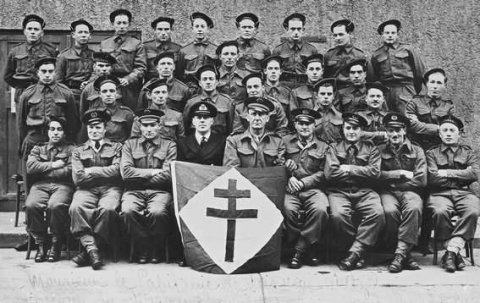
Commando Kieffer. Source: 4th Commando Museum
n the first fifteen minutes, 4 officers were wounded - including Colonel Dawson and Commander Kieffer - and 30 men were killed or wounded. The ”Riva-Bella Casino” episode has remained famous: the German building constructed on the former Casino fired incessantly at the green berets. Medical Officer Captain Lion and Second Lieutenant Hubert were killed. Commander Kieffer went to seek support from the tanks that had recently landed and came back with a tank that reduced the enemy position to silence before it was cleaned out by the commandos.
At approximately 12.30, the survivors were brought together to meet up with the paratroopers from the British 6th Airborne Division at Bénouville. These units were supposed to take two bridges and the locks to keep the Germans from sending in reinforcements to the west of the Orne. In the afternoon, the commandos crossed the Orne at the bridge in Bénouville (”Pegasus Bridge”) to take up positions at Amfréville at around 8 pm. In the following days there were patrols and outpost combat, with the enemy's counterattacks being pushed back on 9 and 10 June. Evacuated to England, Kieffer returned on 14 July with some reinforcements to the combat arena where General Montgomery decorated him with the Military Cross. The French commandos then fought at Bavent Wood above the Dives. On 24 August, there liberated Pont-L'Évêque. Their Normandy campaign lasted for 83 days of continuous action against the enemy. Of the 117 men who landed, only 24 came back unscathed.
The French Naval Forces
Operation Neptune was the naval part of Overlord and the French Navy played an active role as part of the Allied Naval Forces under Admiral Ramsay.
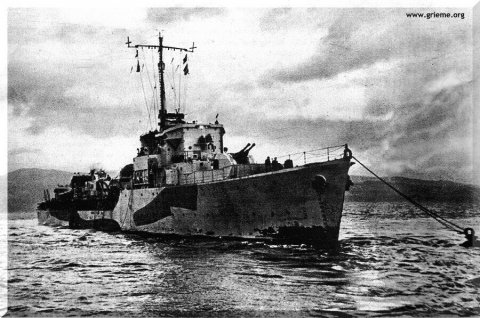
La Combattante, a legendary ship with a well-deserved name -ECPAD Photo
On 6 June, along with the fusiliers-marins commandos, the Free French Forces at Juno Beach had the destroyer La Combattante, which fired on the batteries and blockhouses at Courseulles while the frigate La Découverte and the corvette Commandant-d'Estienne-d'Orves escorted the convoys of Canadian troops. Off Gold Beach, the frigate La Surprise protected British operations. Off Utah Beach, the two corvettes L'Aconit and La Renoncule monitored the possible arrival of two enemy submarines. At Omaha (Vierville, Saint-Laurent and Colleville sector), the frigates Escarmouche and Aventure and the corvette Roselys accompanied the American convoys of the US Army's V Corps. Far off in the Channel, eight French fast patrol boats of the 23rd fleet patrolled tirelessly. On 3 June, two 7,500-tonne cruisers, the Georges-Leygues and the Montcalm, arrived from an Irish port with their 10,000-tonne destroyer tender, the cruiser Duquesne, under the orders of Admiral Jaujard. They took part in the bombing of the defences in the Omaha sector, firing several thousand shells over four days. They withdrew from the action on 16 June.
The corvettes and frigates carried out incessant shuttle runs between English ports and the French coast, providing surveillance for the landing barges and cargo ships loaded with soldiers and equipment on the outbound trip and for the ships carrying the wounded on the return trip, intervening against enemy threats, especially from patrol boats, destroyers, submarines and floating mines. Another ship participated in the landing indirectly: on 9 June, the decommissioned old battleship Courbet was scuttled off Hermann with other ships to serve as a breakwater.
The French Air Force
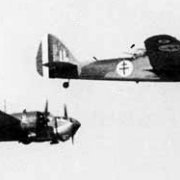
Blenheim of the Lorraine Group. Source: SHD Photo
The French Air Force intervened effectively, successfully completing all its missions. The 1/20 Lorraine light bomber group was able to put up a smokescreen to hamper the German defences at Omaha Beach. The heavy bombers of the Touraine and Tunisie groups and the fighter squadrons Alsace, Ile-de-France, Cigognes and Berry carried out their attacks as part of the attacks by the Allied forces under Air Commander Leigh-Mallory. The French airmen were among the first killed on D-Day: the Boissieux-Canut-Henson crew's ”Boston” took off at dawn with the Lorraine group and never returned from its mission.
Les S.A.S.
The Normandy landing focused attention on those who took part in it, but other Frenchmen were already at work. During the night of 5 to 6 June, two groups of the 2nd paratrooper regiment commanded by Colonel Bourgoin, incorporated into the S.A.S. (Special Airborne Service), were dropped over Brittany with a mission to set up bases for future parachute drops and to carry out sabotage operations to keep German reinforcements from reaching Normandy. The men of Lieutenants Botella and Deschamps thus set up a base in the Forest of Duault, south of Guingamp (Operation Samwest).
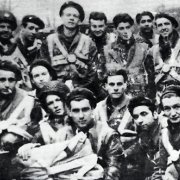
Special Air Service - the S.A.S. Source: DMPA Photo
The group headed by Captains Marienne and Desplante was dropped over the Forest of Saint-Marcel (Operation Dingson) and was detected soon after landing. Corporal Bouëtard was wounded and finished off by a Ukrainian in the German army: he was the first Frenchman killed in combat during the liberation. The group nonetheless managed to get away. It created a rallying point that brought together the heads of the Breton Résistance movement. Other ”sticks” of 3 to 5 men jumped in the night of 6 to 7 June, then on 9 and 17 June. Little by little, the arrival of many maquisards and the supplies dropped by English aircraft made it possible to launch guerrilla operations. The Germans attacked the Duault sector on 11 and 12 June; resistance fighters and paratroopers pushed the attack back before evacuating the base. The base at Saint-Marcel was destroyed on 18 June after violent combat. The fierce repression that followed and the dispersion of the paratroopers, maquisards and F.F.I. was to delay open combat for several weeks. Captain Marienne was killed on 13 July by a Frenchman working for the Gestapo.
General de Gaulle's arrival
Given his tense relations with the American President, Franklin Roosevelt, General de Gaulle was not informed of the date of the landing until two days beforehand. On 14 June 1944 he once again set foot on French soil, landing at a beach on the border between Courseulles and Graye-sur-Mer.
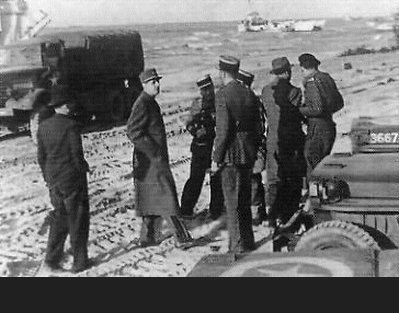
General de Gaulle at Courseulles. Source: Mémorial de Caen Photo
The destroyer La Combattante had left Portsmouth at 8.15 am and at 12.30 the ship arrived off Juno Beach, where an amphibious vehicle deposited the leader of Free France one hour later, followed by a group of 14 people including Generals Koenig and Béthouart (commander of the F.F.I., chief of staff of the French Fighting Forces), Admiral d'Argenlieu (commander of the F.N.F.L.), François Coulet, future Regional Commissioner of the Republic, and Colonel de Chevigné, military delegate of the provisional government.
In his jeep, de Gaulle was taken to the headquarters of General Montgomery, Supreme Commander of the Ground Forces (1st American Army and 2nd British Army) at the Château de Creullet in Creully. The two generals met from 2.15 to 3 pm and then de Gaulle went on to Bayeux, where the population's welcome gave legitimacy to his action. His speech, as well as the speech he was to give at Isigny, laid out his political determination. He re-embarked that very evening at Courseulles, leaving behind him the men who were to take the administration in hand. That same day, on the Caen front, the survivors of the 1st fusilier-marin battalion held a sensitive sector from Caen to Amfréville. Nearly four years after the Armistice of June 1940, the Free French had returned to their homeland.
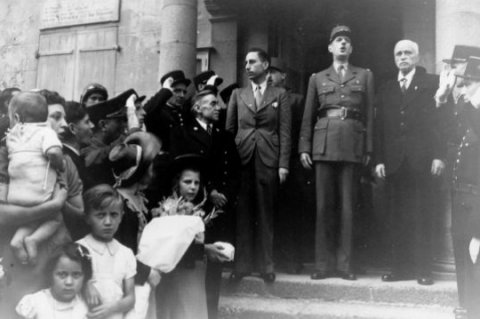
First speech by General de Gaulle at Bayeux, 14 June 1944. Basse-Normandie Regional Council / American National Archives
sites internet externes :
Musée de la Paix
Site du Musée Mémorial d'Omaha Beach
Normandie44 la mémoire


